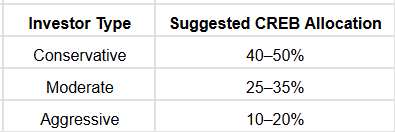Building a resilient, income-generating investment portfolio requires a careful blend of growth assets, defensive instruments, and stable yield sources. In a world shaped by rising inflation, interest-rate volatility, and unpredictable equity cycles, investors are increasingly searching for financial products that deliver stability without sacrificing returns.
Compound Real Estate Bonds (CREBs) are emerging as a differentiated fixed-income asset class designed to provide high APY yield backed by real assets and U.S. Treasuries—while enabling features like anytime withdrawals, auto-investing, and round-ups. For investors navigating modern markets, CREBs may serve as a strong complement to traditional stocks, REITs, and alternative investments.
This blog explores how CREBs can be smartly paired with other asset classes to reduce volatility, improve liquidity, and optimize long-term returns.
Understanding CREBs in a Portfolio Context
CREBs (Compound Real Estate Bonds) are high-yield financial instruments backed by real estate and government obligations, delivering 8.5% APY with no fees, daily compounding, and flexible access.
In a diversified portfolio, every asset should serve a purpose:
- Equities drive growth
- REITs offer real estate exposure + dividends
- Alternatives offer diversification outside public markets
- Cash & bonds provide stability and liquidity
CREBs sit between bonds, private debt, and cash-equivalents. Their key strengths include:
- Predictable yield
- Lower volatility
- Asset-backed protection
- Liquidity anytime
- Higher yield than traditional savings accounts or Treasuries
These characteristics make CREBs appealing for:
- Income stabilization
- Capital preservation
- Diversification
- Liquidity management
As you add CREBs into a broader portfolio, they reduce the impact of stock drawdowns and property-cycle volatility.
CREBs and Traditional Asset Classes
Traditional asset classes fall into three main categories:
Image
CREBs share some similarities with private real-estate debt, but unlike many alternatives, they maintain liquidity and offer consistent yields.
They complement traditional assets by:
- Smoothing returns during downturns
- Offering high yield in low-rate environments
- Providing liquid exposure to real-estate backed credit
CREBs and Stocks (Equities)
Stocks remain the growth engine of most portfolios, but they carry substantial market risk, especially during economic cycles, policy shifts, and earnings downturns. Equities can drop 30–40% in turbulent periods, and income investors often have to wait for long-term recovery.
How CREBs Complement Equities
- Reduced Volatility
CREBs provide fixed yield regardless of market sentiment. - Income Stability
Where equities rely on dividends (if offered), CREBs compound daily. - Risk-Adjusted Return Enhancement
Adding stable return streams can increase Sharpe ratios. - Buffer During Drawdowns
When stocks fall, CREB income continues uninterrupted.
CREBs and REITs (Real Estate Investment Trusts)
REITs are publicly traded vehicles that generate dividends from real estate holdings. They can be powerful income vehicles but are tied to the stock market.
Differences Between CREBs and REITs
Image
REIT prices move based on:
- Occupancy rates
- Interest-rate expectations
- Stock-market sentiment
CREBs are designed to remain stable regardless of market cycles.
How They Fit Together
- REITs provide upside opportunity.
- CREBs provide consistent yield.
Together, they create a balanced real-estate income sleeve.
CREBs and Alternatives (Private Equity, Hedge Funds)
Alternatives attempt to generate alpha outside traditional markets but require:
- Long lockups
- High minimums
- Manager selection skill
- Complex tax treatment
Compared to these:
- CREBs are accessible with as little as $10
- Withdrawable anytime
- Non-correlated to equity cycles
- Transparent fee structure (no fees)
Portfolio Psychology
Alternatives often demand patience.
CREBs reward consistency.
When paired:
- PE may deliver growth in multi-year horizons
- CREBs enhance short-term yield stability
Building the Optimized Portfolio
Modern portfolio construction focuses on correlation control. Correlation measures how assets move relative to each other.
- Stocks, REITs, and hedge funds often move together during stress events.
- CREBs are uncorrelated, maintaining consistent yield.
This property makes CREBs a valuable building block in:
- Retirement income portfolios
- Barbell strategies
- Risk-parity frameworks
- Yield ladders
Example: Balanced Allocation

CREBs reduce portfolio beta, helping stabilize returns.
Strategic Allocation Approaches
Investors can use several methods:
1. Income Sleeve Approach
Allocate CREBs to the portion of the portfolio dedicated to yield.
2. Volatility Offset
Decrease equity exposure by 5–10% and shift into CREBs to smooth returns.
3. Tactical Rebalancing
During down markets, CREB income can be used to:
- Buy discounted equities
- Increase other holdings without selling at losses
- Add optionality
4. Liquidity Reserve Strategy
Since CREBs provide anytime withdrawals, investors can use them as an emergency income buffer.
Risks and Considerations
Although CREBs offer strong benefits, investors should consider:
Interest-Rate Environment
CREB yields remain fixed and predictable, but overall fixed-income markets shift with macroeconomic cycles.
Manager Risk
Always ensure the platform is transparent, well-capitalized, and regulated.
Reinvestment Risk
As income accumulates, investors must allocate it wisely (CREB auto-investing solves this).
Opportunity Cost
Cash parked outside CREBs may earn far less, especially during inflationary periods.
Conclusion
CREBs occupy a unique place in modern portfolio construction. Their blend of:
- Fixed 8.5% APY
- Daily compounding
- Asset-backed security
- Anytime liquidity
makes them an attractive complement to traditional stocks, REITs, and alternatives.
By offering stable income and low correlation, CREBs enhance diversification, improve risk-adjusted returns, and protect against market drawdowns—without requiring specialized knowledge or high minimums.
For investors seeking more predictable income while maintaining flexibility, CREBs may be one of the most efficient fixed-income additions available today.

FAQs
How do CREBs differ from traditional bonds and REITs?
Traditional bonds are heavily rate-sensitive, while REITs fluctuate with equity markets. CREBs offer fixed yield backed by real assets without market volatility.
Can I hold CREBs in the same portfolio as stocks and mutual funds?
Yes. In fact, combining them creates smoother return profiles through diversification.
Are CREBs correlated with stock-market movements?
No. CREBs provide fixed returns regardless of equity performance.
How much of my portfolio should be in CREBs?
Depending on risk tolerance, 10–50% is reasonable for diversification and income stabilization.
Are CREBs considered a “safe” investment?
They are backed by real assets and U.S. Treasuries, offer anytime withdrawals, and exhibit low volatility. As with any investment, due diligence is recommended.
Do CREBs offer better risk-adjusted returns than REITs?
For many investors, yes. CREBs deliver consistent compounding yield without price fluctuation, while REITs can lose value in downturns.









.png)